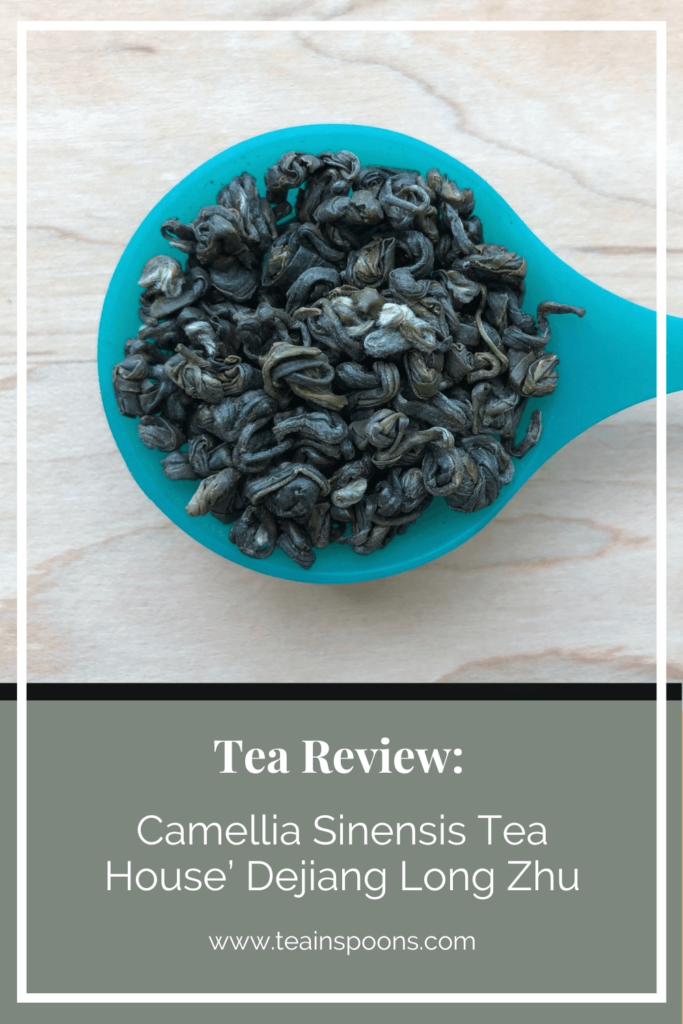
Since I can’t travel right now, tea is my way to visit different places around the world. I purchased this one because Camellia Sinensis Tea House had two teas from the same producer – a green and a black tea and I always like to compare teas!
Description: “A bold and frankly vegetable liquor, evoking the taste of snow peas.”
Instructions: 4 grams | 85°C (185° F) | Infusion 1 (20-35 seconds), Infusion 2 (15-30 seconds), Infusion 3 (30-45 seconds)
Review: This week, I will be focusing on the green tea from M. Qi and next week it will be the black tea. The Camellia Sinensis website described the green tea as “[c]oming straight from a garden project perched at 1,200 meters above sea level in eastern Guizhou, in China, this tea harvested from young plants of the Fuding Da Bai cultivar was grown without chemicals.”
The website had brewing recommendations for a teapot and a gaiwan, so, I decided to brew the tea Western (with a cup) and Gong Gu (with a gaiwan) style. The dry green tea had dark forest green leaves with some paler green ones which were all small and tightly rolled with a faint grassy smell.
Gong Fu Style (Gaiwan):

Pre-warmed gaiwan: The website didn’t mention rinsing the leaves, so I did not. However, I always like to warm up my tea vessel and cups. I added the dry leaves to the warmed gaiwan and the leaves had a sweet grassy and roasted smell.
Infusion 1 (30 seconds): After adding the water, the liquor became a very pale yellow colour which almost wasn’t noticeable. Since it was so light, I didn’t expect much flavour, but it had a steamed vegetable, asparagus, bean sprout, and nutty taste with a slightly syrupy mouthfeel. The liquor had some bitterness and dryness at the back of the throat and tasted more mineral when cooled.
Infusion 2 (20 seconds): The tea became a darker yellow-green colour and was slightly hazy. The taste had a shaper fresh cut grass and vegetal note which was refreshing. It reminded me of fresh peas, spinach, peanuts, and ended a with pine note at the end of the sip.
Infusion 3 (35 seconds): The liquor was a slightly dark neon yellow-green and was less sharp in taste. The flavour was fading with more dryness at the back of the sip and a hint of bitterness.

Wet leaves: The leaves were olive yellow-green in colour and made of buds and small leaves with a roasted, vegetal, and grassy smell.
Western Style (Cup):

One teaspoon of green tea was brewed at 85°C temperature with 250 ml of water for 3 mins and 30 seconds. Since it was a longer brew than in the gaiwan, the liquor picked up a darker pale yellow colour. It had a roasted, vegetal, and steamed vegetable smell. The taste was peppery, fresh cut grass, steamed greens, and chestnuts with dryness at the back of the throat. The liquor had a stronger vegetal and roasted note when cooled.
Overall:
Having tried this green tea a few times, I found adding a few extra seconds during each infusion did help bring out the flavour. I generally like brewing at the lower time recommended but in this case and it was worth the trade-off to have a bit of dryness and bitterness for more flavour. Personally, I liked brewing it Gong Fu style with a gaiwan as it brought out a richer cast of flavours. This is a nice green tea with notes of vegetal to roasted. People who enjoy Chinese green teas or more delicate green teas with grassy or vegetal flavours will enjoy this tea (3.5/5 rating).
- Type: Green tea
- Origin: China, Guizhou
- Caffeine: Unknown
- Ingredients: Green tea
- Company: Camellia Sinensis Tea House
The question of the post: Do you like stong or delicate green tea?
Liked this review of Camellia Sinensis Tea House’ Dejiang Long Zhu? Pin it!

